Eating plenty of whole, plant-based foods is critical for optimal health. However, that does mean you’ll be spending a lot of time in the kitchen, prepping and cooking food.
There are many tools that can make healthy eating easier, but one of the most important is also one of the most basic: a good knife.
Quality knives make cooking and food prep quick and enjoyable. On the other hand, a bad knife will swiftly make you frustrated and may lead to injury.
How do you choose the best knives for your kitchen?
Many people find themselves lost at sea when it comes to knife selection, so here’s a straightforward guide to choosing the right knives, including a newer knife option you may not have heard of.
Knives: A Chef’s Secret Weapon
Most of us will never be world-class chefs, but we can learn something from the masters of this craft: A sharp, effective knife is one of the cornerstones of great tasting food.
Before we get into the basics of how to choose a good knife, here’s a quick look at some knife terminology to help you feel (and be) more professional in your selection.
There are two basic parts to a knife— the handle and the blade. Obviously, the blade is most important from a cutting and chopping perspective, but the handle also needs to be considered because it keeps your hand comfortable (or not) as you work.
The sharp side of the blade is known as the edge, while the top (non-sharp) side is known as the spine. Many knives have a bolster, which is a thicker band that connects the blade and the handle. Other knives (particularly Japanese-style) lack this piece.
Knives also have a heel, which is typically the broadest and thickest part of the knife, found at the base of the blade. This part helps you to get extra force when cutting tough ingredients, like the rind of winter squash.
A Tip for Saving Your Fingers
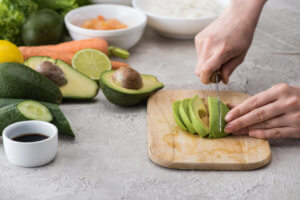
Choosing a good quality knife may save you a trip to the emergency room. Dull, poor quality knives are harder to work with, which increases your chances of slipping as you cut through produce and slicing your finger.
However, it’s also a good idea to brush up on a few basic knife skills to go with your carefully chosen knives. Learning how to hold and chop fruits, veggies, etc. is another way to keep all your fingers intact.
Here’s an example to consider…
The most dangerous piece of food to cut is none other than the avocado. There have been an estimated 50,413 emergency room visits due to knife-related avocado injuries over the last 20 years. That’s over 2500 hospital trips per year!
The bottom line: Get quality knives, learn how to use them, and save on medical bills. (Plus, consider using a spoon to take out an avocado pit.)
Key Considerations for Choosing the Right Knives
Sharpness & Hardness
Sharpness is one of the biggest hallmarks of a quality knife. This is what allows you to cut through food quickly and efficiently, making food prep much easier.
Now, most knives will come to you sharp, but the question is: How long will they maintain that sharpness?
A knife that goes dull quickly is a recipe for frustration. You will either be forced to sharpen it constantly, or you’ll be using a lot more muscle to cut produce with a dull blade. (Or you’ll be looking for a new knife set.)
In general, the harder the material used to make a knife is, the longer it will stay sharp.
The best way to find out this crucial information is to ask before buying. You can do so by requesting the Rockwell rating of a specific knife. This refers to a number given by the Rockwell hardness test, which is an industry standard for testing the hardness of knives.
A higher Rockwell number indicates a harder blade. Generally, anything over 56 is considered hard with premium steel falling in the range of 59-66.
Care Required
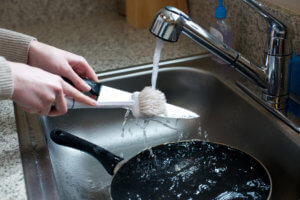
Something else to consider when choosing a knife is how much care it will require. Most knives need at least a little maintenance to stay in good working order, but you don’t want to be fussing over them all the time.
Obviously, one aspect of this is getting a knife that doesn’t need to be sharpened constantly. A harder knife should keep its edge longer, although a super hard knife will be more difficult to sharpen when it does go dull.
Another consideration is cleaning.
Steel, which is the material used in most blades, will rust if not properly cleaned and dried. Stainless steel is more resistant to rust and stains (as the name indicates) than other types of steel. Carbon steel, on the other hand, is more prone to rust but holds a better edge.
You can also go with a combination of stainless and carbon steel to get “the best of both worlds”. Or you can opt for a non-metallic ceramic knife that is easier to care for than any type of steel.
Weight & Balance
Finding the right weight and balance in a knife is important, especially if you do a lot of chopping. However, this is also a very subjective part of knife selection— something everyone will differ on in some way.
Many people prefer a more lightweight knife because it’s easier to handle, but some think a heavier knife cuts better because it has more force. This is very much a personal preference, and it’s not a bad idea to experiment with different weights to see which works better for you.
Balance refers to how a knife feels in your palm. It shouldn’t feel like there is too much weight forward on the blade or back in the handle. Essentially, you want a knife that feels stable when you cut with it, not one you feel like you have to keep in check.
Comfortable Handle
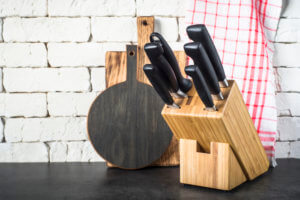
If you’ve ever had a hand cramp after holding a knife, you know the importance of a good handle. You want your knives to feel comfortable, even after using them for long periods of time.
Generally speaking, smooth handles tend to be the most ergonomic. Those with grooves or indentations cause awkward finger placement for the majority of users, even though they are meant to be helpful.
That being said, you don’t want a handle that feels slippery. Plastic and synthetic materials fall on the slippery side (and are made with toxic chemicals), while wood and metal give you a better grip. You should also have plenty of clearance under the knife when you chop— no fingers banging into the counter.
The size of the handle is mostly a personal preference. Larger hands may need a larger handle, smaller hands a smaller one, and so on.
Knife Size
Having knives in a few different lengths is ideal for cutting different types of foods. Longer knives can go through something large, like a watermelon, but are harder to control. The reverse is true for smaller knives.
Chef’s knives typically come in a range of 6-10″. The sweet spot for many people is an 8″ blade because it falls right in the middle of control and length.
You may want to add in a longer knife if you tend to work with large, tough produce. A small (4″) paring knife is also very useful for cutting and peeling smaller fruits and vegetables.
Durability
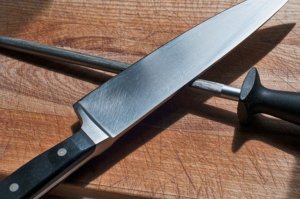
Once you go through the hard work of choosing the right knives, you want them to last for a long time.
To give you some more knife terminology, there are two main types of steel knives: forged and stamped.
Forged knives are created out of a single piece of molten steel that is cut and beaten into the right shape. They are less likely to bend than stamped knives and are usually the higher quality and more durable of the two.
Stamped knives are more of a “cookie cutter” option created by a machine. It’s not impossible to find a good quality stamped knife, but overall they tend to bend more easily and wear out more quickly than forged knives.
Another type of knife that will last through many years of use is ceramic (more on this material shortly). Quality ceramic knives have both good durability and exceptional hardness with the potential to outlast steel.
Material
Most knife blades are made out of steel. As mentioned earlier, stainless steel is the best option for easy cleaning, while carbon steel is harder and holds a better edge. A good mix of the two qualities is a high-carbon stainless steel knife, which resists rust and is fairly hard.
Many people are comfortable with a classic German-style steel knife, but Japanese-style options are growing in popularity.
Japanese-style knives are typically much lighter than German-style with a thinner blade. They tend to have a straighter edge and can be very precise, but don’t always rock as smoothly as more rounded blades.
Another option that deserves your attention is ceramic knives.
You may never have thought of using a ceramic knife, but they have some fantastic benefits, including being much harder and holding a better edge than steel. In fact, they deserve their own section to fully fill you in on the details…
Ceramic Knives: The Sharpest You’ll Find
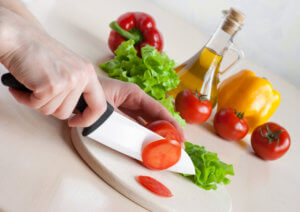
Ceramic may seem like a surprising choice for knife material— until you learn what all it can do.
Now, to begin with, ceramic knives are not made of the same material you would find in a ceramic mug. They are made from zirconia, which is a natural material that can be up to 10 times harder than steel. In fact, the only harder known material than zirconium ceramic is a diamond.
This hardness translates to a sharper blade that lasts 10 times longer than a steel blade. A quality ceramic blade can cut through a tomato or a watermelon with the same ease.
Despite this incredible sharpness and durability, ceramic knives are extremely lightweight. This makes them very easy to handle and excellent for precision cutting.
Because there is no metal in the blade, you’ll never have to worry about rust with a ceramic knife. The blade itself is dense, rather than porous, which means odors won’t transfer from one ingredient to another. Ceramic also naturally resists bacterial growth and won’t stain.
A final huge benefit to ceramic knives is the price. A high quality set made from ceramic costs significantly less than a high quality steel set, which makes them affordable for almost everyone.
Top Recommendation: P600 Ceramic Knives from Chefs Foundry
If you are interested in trying a top quality ceramic knife set, look into the P600 Ceramic Knives from Chefs Foundry, which is why my wife and I now use.
These ultra-sharp knives are lightweight, easy to handle, and versatile for all kinds of chopping, slicing, dicing, etc. They are significantly harder and sharper than steel and make everyday food prep fast and easy. The set includes an 8″ chef’s knife, 6″ utility knife, and 4″ paring knife.
Head here to learn more about the P600 Ceramic Knife Set and trade in dull, inefficient knives for something that makes cooking healthy food enjoyable.

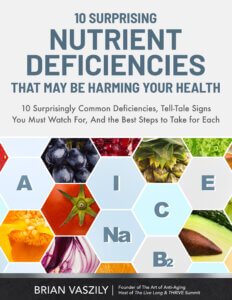
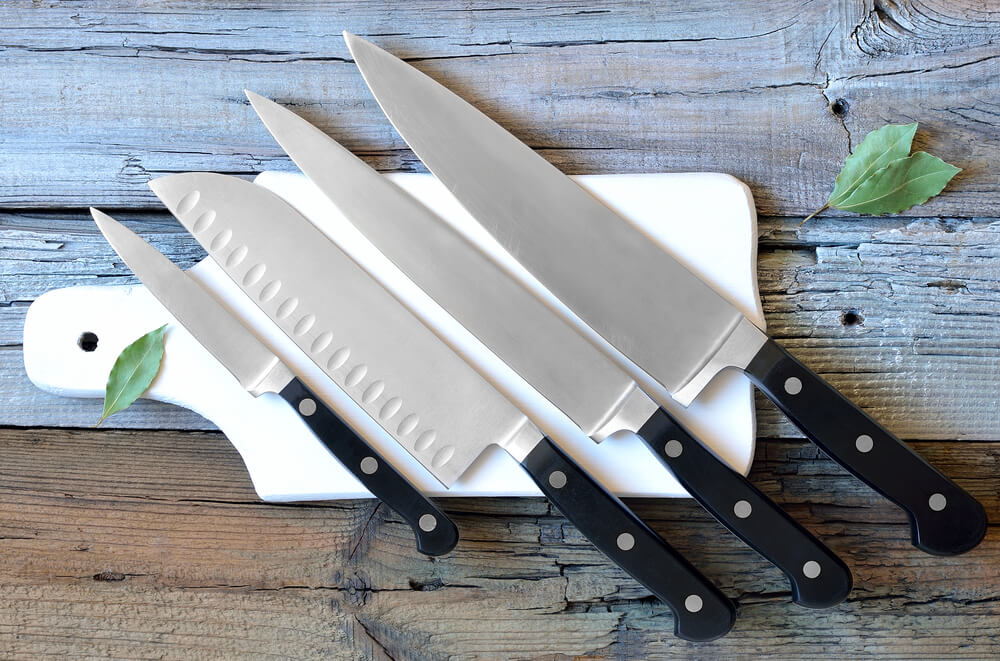
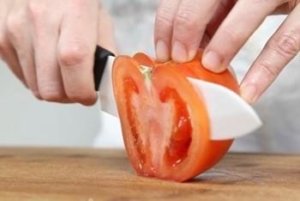
Enjoyed the article learned a lot about knifes Thank very helpful information.
Are these CutCo Knives?
Most practical information about knives and how select knives when buying.
Ceramic, really? I just invested in Global knives a few years ago or else I’d try ceramic.
Thank you for this very informative article about knives. I agree that good knives are essential in the kitchen. I currently have a ceramic knife of another brand, and it was very sharp at the beginning, but not so much now. Before I purchase additional ones, please tell me how is the best way to sharpen a ceramic knife?
Thank you.
I also enjoyed your article. I’ve gathered more than a few knives in the kitchen, and have been amazed at how inexpensively high quality knives can be found at yard sales and thrift stores. They certainly don’t show up every day – more of a rare find, but they’re a great find for someone who prepares a lot of food.
I’ve used several ceramic knives over the years, always purchased new. Wow are they sharp. They hold an edge that can slice the ripest tomatoes with ease. But there are a few things about them worth mentioning – things that explain why I reach for high quality stainless knives more often.
First, while ceramic knives are amazingly sharp when you get them, they will eventually become dull. It takes a lot longer than a metal blade, but it eventually happens. That’s when you find out you can’t sharpen them easily, if at all… or you find out that the specialized sharpener you would need is pretty expensive.
Second, the ceramic material is very brittle. Drop it on a hard surface, and you can easily lose the tip or chip the blade (it happens far too easily).
Third, If you put too much pressure on them, like trying to cut through a big hard squash or rutabaga, they break far more easily than a decent quality steel chef’s knife. The weakest point with the most force on it for most knives would be where the blade meets the handle.
Finally, with metal blades, they dull when passing over harder materials by deforming (metal will bend and deform to an extent) and by rubbing some of the metal off usually as a fine dust – onto stone countertops, ceramic plates, pots, pans, bowls, and bones you may be cutting against. But ceramics are harder. They dull by microchipping. If you look at the edge of a slightly dull ceramic knife under magnification (I did) it looks like a bunch of really tiny chips missing along the edge. Where do these chips go? I’m not happy with the answer.
So for myself, ceramic knives are especially great for cutting veggies and fruit – especially softer vegetables and fruits. That’s where they’re really fantastic. If used for that purpose on a wood/plastic/bamboo cutting board, and protected from chipping, they’re great knives that will last for years or decades. But they’re too brittle and fragile for cutting hard or frozen foods, or for use on hard surfaces, like most plates, pans, bowls, or hard cutting boards. And I wouldn’t put them in a dishwasher to be rattled around with other utensils that might cause little chips along the edge.
Combined with what Brian wrote, I now feel well informed about which knife to use in its ideal application. I thank both of you for educating me.
Outstanding reply! I was going to mention brittleness, as well, but you covered it brilliantly 🙂
Otherwise, the article itself was pretty darn thorough – thank you, Brian!
Thank you, that was most useful!
Great information. Ceramic knives certainly look like an excellent choice. Thank you for the education!
I’ve had a variety of kitchen knives throughout the decades of my life; the biggest problem I have myself is in sharpening them properly. I have had a few ceramic kitchen knives and found them to be brittle under hard use. the sharpness can be beat especially slicing tomatoes.
Most useful information I have ever read on knives. I have looked at the knives illustrated on the pages – all of them are shaped straight and pointed. There is a popular variety of sickle-shaped light-weight chopper, being used in my part of the world in India, which is made of carbon steel and extremely efficient. To make fine chops the kitchen worker holds the vegetable in the left palm and uses a rubber finger cap on the left forefinger to prevent injury while chopping at a fast pace with the sharp cutter.
A very helpful and interesting article.
ALL kitchen knives should be kept seperate from dishes silverware and other utensils. They should be washed rinsed and dryed individually preferably after each use and stored in a holder or magnetic strip that keeps them seperate and they will last a long time and stay sharp.
Thanks for the info. So many people don’t know much about knife etiquette. It’s good to be able to better understand how to care for a knife. Regarding ceramic, I think there’s a learning curve. I’ve tried a few and have yet to find one that ‘feels’ right. I suppose I have a way to go to get used to the different nature of ceramic, but so far they kind of scare me. I’ve come too close to cutting myself, not that that can’t happened with a steel knife, but with ceramic it ‘feels’ like I need to be extra careful. So far, I keep reaching for my favorite 8″ stainless steel. Also, as someone else mentioned, I’ve found some great knives at thrift stores.
I agree ceramic knives are a good addition to a working kitchen. It’s true they are breakable. As taught to us as a major supermarket’s cooking class, they have a major advantage over medal knives when cutting avocados: the flesh of an avocado turns brown when cut with a metal knife. This does not happen with a ceramic knife. Ultimately air will turn avocado flesh brown, but it won’t happen right away because the avocado flesh won’t react to the ceramic knife. This is true when cutting apples as well. Nice to know!
Great article. Very useful
A very informative article about knives. My set of carbon.steel knives was a great investment at the time .They have lasted well and still cut very well after nearly 50 years. Curious about the ceramic knives . Might just invest in one out of curiosity.
Thank you
Kameela